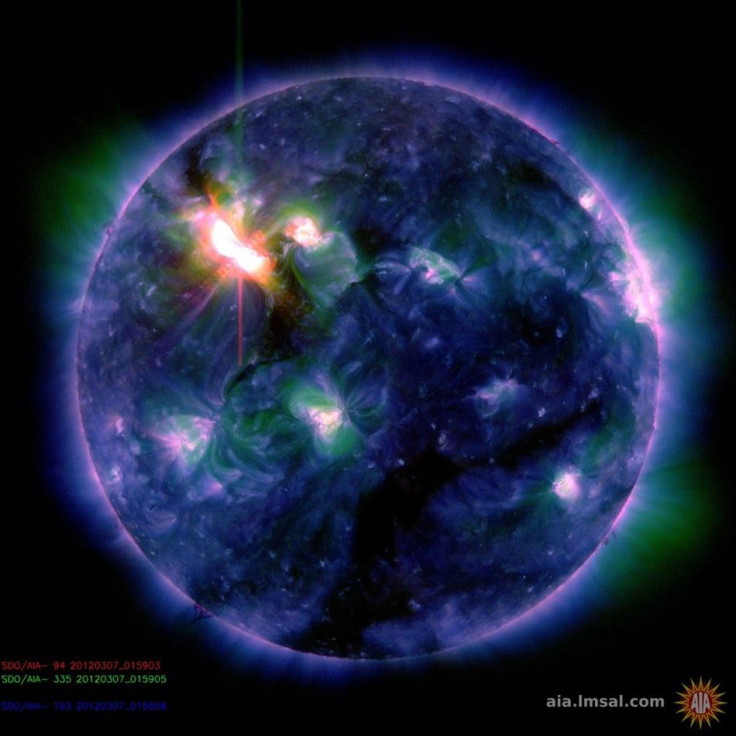Planet Unprepared For Solar Storms That Could Cost Trillions: Researcher

Earthlings are woefully unprotected from solar storms that, if powerful enough, could cause trillions of dollars in damage from widespread blackouts and disrupted satellite navigation, according to an editorial from RAL Space, a UK-based space research organization.
Solar storms generate intense bursts of solar radiation that hits Earth at speeds exceeding 3 million miles per hour (5 million km/h) and can wreak havoc on the power grid, according to NASA researchers.
A strong solar storm could expose people's dependence on electricity and GPS satellites, RAL Space researcher Mike Hapgood wrote in a commentary published in the journal Nature on Thursday.
Over the past few decades, we have become much more dependent on technology to sustain our everyday lives: e.g., electricity to pump clean water to our homes and remove sewage, just-in-time supply chains to feed us, ATMs and retail card readers to provide money for everyday shopping, Hapgood told Space.com. Do we know how to recover quickly from the simultaneous disruption of a huge range of systems?
Strong solar storms have wiped out electrical infrastructure. In 1989, a solar storm knocked out power across parts of Canada for hours, leaving millions in the dark. The largest solar storm in history, called the Carrington event, caused telegraph lines to short out and catch fire in 1859. Technology was scarce back then, Hapgood said. If a storm like the Carrington event hit today, it would cause pandemonium, he estimated.
If we had a repeat of the Carrington event, I would expect several days of economic and social mayhem as many critical technological systems failed - e.g., localized power grid failures in many countries, widespread loss of GPS signals for navigation and timing, disruption of communications systems [and] shutdown of long-haul aviation, he told Space.com.
Solar storms increase the electric current of the ionosphere, a part of Earth's atmosphere. Many communications systems, such as AM radio, transmit signals over long distances using the ionosphere as a reflector. Increases in electric current can disrupt that reflection. Airlines rely on radio to communicate with ground control, and solar storms can disrupt that communication.
Flares also cause a change in the density of the ionosphere and cause GPS systems to become less precise, experts said. Magnetic fields that accompany solar storms can short electrical grids and knock out power.
Solar storms also cause more innocuous auroras, a collection of green, red and blue lights strongest around the poles. Strong solar storms can create auroras as far south as the Great Lakes.
The sun maintains an 11-year solar cycle of two periods: solar maximum and solar minimum, measured by the number of sunspots. Solar storms usually occur in the presence of sunspots, according to NASA.
During solar maximum, several hundred sunspots dot the sun each day, but several days may pass without any sunspots during solar minimum. The sun entered solar minimum in 2007.
The Space Weather Prediction Center warns of strong solar storms up to 60 minutes in advance with approximately 50 percent accuracy, an inadequate window of time for power companies to prepare, experts said. The center relies on data from spacecraft in order to predict coming storms, but many of the crafts are outdated, Hapgood wrote. He recommended updating the instruments on the spacecraft in order to optimize them for space weather monitoring.
Hapgood also recommended upgrading transformers to withstand strong solar storms and digitizing records of previous solar storms for further study.
Most importantly, decision makers need to be aware of the problem, Hapgood wrote. People regard it as a far-off possibility, but while a strong solar storm may not hit anytime soon, it's a matter of when, not if.
Some government officials are starting to take notice.
This threat of geomagnetic disturbance has a lot of attention in Washington, William Bryan, a deputy assistant secretary at the U.S. Department of Energy, told Florida Today. This is not science fiction. It's real. These things are really happening and could really have an impact on us.
But until more people are aware of the potential dangers and the planet begins to take protective measures, the Earth is in real danger, Hapgood said.
These events often transcend the experience of any individual because they happen so rarely, he told Space.com. But these events will happen sometime. We need to understand them and decide how far we should (i.e., can afford to) protect against them -- and definitely not leave them until it's too late.
© Copyright IBTimes 2025. All rights reserved.





















